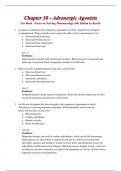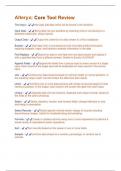Exam (elaborations)
Chapter 30 - Adrenergic Agonists Test Bank - Focus on Nursing Pharmacology (8th Edition by Karch)
- Course
- Institution
1. A patient is admitted to the emergency department in shock. Isoproterenol (Isuprel) is administered. What would the nurse expect the effect of the isoproterenol to be? a. Increased blood pressure b. Decreased blood pressure c. Increased body temperature d. Decreased heart rate Ans: A Fee...
[Show more]




